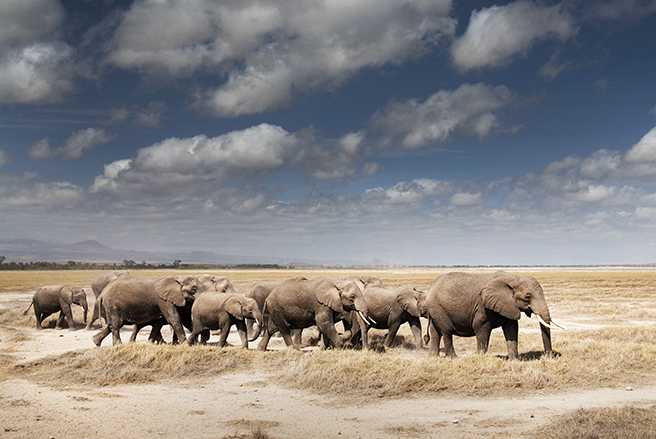The Silent Killer of Africa's Wildlife

The following is an excerpt from "Habitat Loss: Wildlife's Silent Killer and the Central Role Protected Areas Play on Biodiversity Protection in Africa," a chapter written by AWF's Vice President of Conservation Strategy, Kathleen Fitzgerald, in Island Press' new book Protecting the Wild: Parks and Wilderness, the Foundation for Conservation.
Sitting on the banks of the Olifants River in Kruger National Park, we watch as over 60 elephants gather in the river. They are cooling themselves, drinking water and spraying themselves with moist river sand. The herd comprises all ages—an awesome assortment of sizes. The matriarch, an enormous female, starts walking downstream and all the elephants slowly follow. The terrain is steep, rocky, and variable, but the elephants navigate their way in single file. Along the bank is an area of sand that slopes down toward the river. When the matriarch approaches the top of the bank, she looks down, leans onto her back knees, and slides down. Imagine a three-ton animal sand-sledding. It is incredible to watch; the scene makes it hard not to imagine hearing an anthropomorphic “Yee-haw” coming out of their mouths. We sit in awe watching as each elephant in turn follows the matriarch’s action and does the same.
When one of the baby elephants followed follows suit, rather than sledding easily down like the others, she was forced into somersaults by the river bank’s steepness and rolled down, spiraling like a tire going down a hill, and landed at the bottom on her back with her legs flailing up in the air. One of the other elephants trumpeted, and immediately six elephants ran to help her. They protectively surrounded the baby and nudged her over and up onto her feet, whereupon she wobbled off, flanked by her protectors, the collective herd giving an amazing glimpse into the complex familial systems of elephants.
The African elephant (Loxodonta Africana) is just one of Africa’s unique and iconic species threatened by a severe poaching crisis gripping the continent and driven by an insatiable demand for ivory in Asia. The Convention on International Trade in Endangered Species of Wild Fauna and Flora (CITES) estimates that more than 25,000 elephants were poached in 2011, a staggering number. Other evidence suggests the year-to-year figures are much higher. Enormous time, energy, and resources are necessarily being invested in Africa’s wildlife in an attempt to stop the poaching, trafficking, and demand. Even if we stop the current onslaught of poaching, however, viable populations of in situ wildlife in Africa will not survive given present rates of habitat loss. Habitat loss is African wildlife’s silent killer, and it needs urgent attention.
The survival of Africa’s wildlife is dependent on large, wild protected lands and requires a deliberate choice by African governments to protect habitat for these species. The range of the African elephant, a conservation dependent species, for example, has declined significantly over the past two decades. Only 31 percent of the elephant range lies in protected areas, which cover approximately 9 percent of the continent, putting the future of this magnificent species at risk.
A similar situation exists for Africa’s four great apes, which are concentrated in forest landscapes in West and Central Africa. The chimpanzee, the most populous of all great apes, has four subspecies: Central, Eastern, Western, and Nigeria-Cameroon chimpanzee, and all subspecies are in decline and listed as Endangered with only 22 percent of their suitable habitat secured in protected areas.
Drivers of Habitat Loss
What are the main factors leading to accelerated habitat loss across the continent?
The simple answer is growth. This includes economic, population, development, resource extraction, agricultural, and international growth—all of which is directly and indirectly resulting in habitat loss.
In the past decade, Africa’s growth rates have been approaching those of Asia. In 2011, seven African countries were among the world’s ten fastest-growing economies, with each having an annual growth rate of 8 percent or more. The African Development Bank projects that by the year 2030 Africa’s population will grow to 1.6 billion—up from 1 billion today—representing 19 percent of the world’s population. With more people and an expanding economy come new and increasing demands on land and natural resources, resulting in habitat conversion and fragmentation if not managed properly...
Continue learning about the essential role protected areas play in conserving Africa's biodiversity, and hear from other wildlife conservation leaders like Jane Goodall, Daniel Doak and George Monbiot, with your own copy of Protecting the Wild.
Photo: Billy Dodson